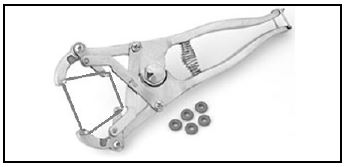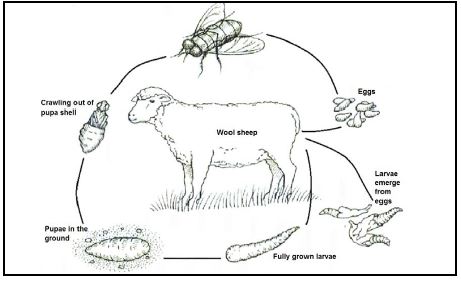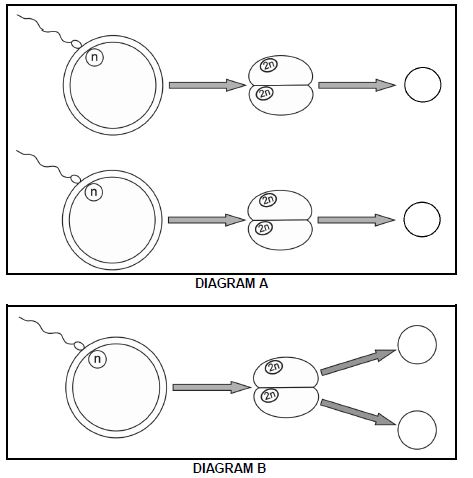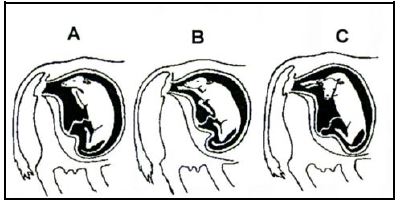AGRICULTURAL SCIENCES PAPER 1 GRADE 12 QUESTIONS - NSC PAST PAPERS AND MEMOS NOVEMBER 2016
Share via Whatsapp Join our WhatsApp Group Join our Telegram GroupAGRICULTURAL SCIENCES
PAPER ONE (P1)
GRADE 12
NSC EXAM PAPERS AND MEMOS
NOVEMBER 2016
INSTRUCTIONS AND INFORMATION
- This question paper consists of TWO sections, namely SECTION A and SECTION B.
- Answer ALL the questions in the ANSWER BOOK.
- Start EACH question on a NEW page.
- Number the answers correctly according to the numbering system used in this question paper.
- You may use a non-programmable calculator.
- Show ALL calculations, including formulae, where applicable.
- Write neatly and legibly.
QUESTIONS
SECTION A
QUESTION 1
1.1 Various options are provided as possible answers to the following questions. Write down the question number (1.1.1–1.1.10), choose the answer and make a cross (X) over the letter (A–D) of your choice in the ANSWER BOOK.
EXAMPLE:
1.1.11 ![]()
1.1.1 Farm animals that chew on foreign objects, like rags, show a symptom of a/an … deficiency.
- iron
- phosphorus
- copper
- sodium
1.1.2 To ensure an increased population of cellulolytic organisms in the rumen, the farmer should feed animals large quantities of ...
- roughage.
- starch.
- vitamins.
- Protein.
1.1.3 Young, growing animals require feed with a narrow nutritive ratio because ...
- it supplies more carbohydrates than protein.
- the level of protein is equivalent to that of carbohydrates.
- it has more protein than carbohydrates and minerals.
- protein is directly proportional to carbohydrates.
1.1.4 The non-nitrogen content in a feed with a TDN of 75% and DP of 12%:
- 87%
- 25%
- 63%
- 75%
1.1.5 The statements below apply to the management of chickens in an intensive production unit:
- Selection of high-quality chickens
- Inadequate floor space and feeding space
- Easy cleaning of broiler house
- Economy of construction of broiler house
Choose the CORRECT combination:- (i), (ii) and (iii)
- (ii), (iii) and (iv)
- (i), (ii) and (iv)
- (i), (iii) and (iv)
1.1.6 The following is NOT a measure to prevent absorption of a poison already ingested:
- Animals should be kept away from drinking water.
- Administer tannic acid.
- Dose animals with sugar or glucose.
- Provide supplementary feeding.
1.1.7 Examples of production systems applicable to pigs:
- Backyard and free range
- Backyard and deep litter
- House run and free range
- Free range and deep litter
1.1.8 Which ONE of the statements below about the seriousness of animal diseases is INCORRECT?
- Chronic diseases are long-lasting and recur in the same animals.
- Peracute diseases are sudden and animals die without previous signs.
- Acute diseases are sudden and may become chronic.
- Acute diseases cannot be cured.
1.1.9 A visible sign of a cow that is about to go into parturition:
- Rhythmic contraction of the muscles of the uterus
- Frequent urination and defecation
- Enlarged vagina and cervix to form one common canal
- Cow searching for a bull
1.1.10 A hormone in lucerne and clover pastures that may lead to pregnant animals coming into oestrus:
- Relaxin
- Oxytocin
- Oestrogen
- Prolactin (10 x 2)
(20)
1.2 Indicate whether each of the descriptions in COLUMN B applies to A ONLY, B ONLY, BOTH A AND B or NONE of the items in COLUMN A. Write A only, B only, both A and B or none next to the question number (1.2.1–1.2.5) in the ANSWER BOOK, for example 1.2.6 B only.
COLUMN A | COLUMN B | ||
1.2.1 | A: | Biuret | A protein supplement in the ration of ruminant animals during dry winter months |
B: | Molasses | ||
1.2.2 | A: | Tranquillisers | Substances given to animals to regulate metabolism and growth rate |
B: | Antibiotics | ||
1.2.3 | A: | Modified environment | Intensive production system |
B: | Feeding closely monitored | ||
1.2.4 | A: | Dosing | Appropriate method of administering medicines for the treatment of external parasites |
B: | Spraying | ||
1.2.5 | A: | Embryo transplant | Removal and transfer of fertilised ova from genetically superior cows into the uterus of recipient cows |
B: | Artificial insemination | ||
(5 x 2) (10)
1.3 Give ONE word/term for each of the following descriptions. Write only the word/term next to the question number (1.3.1–1.3.5) in the ANSWER BOOK.
1.3.1 A metabolic disorder resulting from a vitamin B1 deficiency that causes neuromuscular problems
1.3.2 The type of host represented by a snail in the life cycle of a fluke worm
1.3.3 The normal animal birth presentation where the head rests on the feet and the nose is stretched towards the pelvis
1.3.4 The process during which the nucleus of a female egg cell is removed for nuclear transfer
1.3.5 A device that is placed around the lower leg of a cow on heat to detect and record movement (5 x 2)
(10)
1.4 Change the UNDERLINED WORD(S) in each of the following statements to make them TRUE. Write only the answer next to the question number (1.4.1–1.4.5) in the ANSWER BOOK.
1.4.1 Fodder flow refers to the amount of feed consumed by an animal to gain a kilogram of body weight.
1.4.2 Foot-and-mouth disease is a non-contagious animal disease whereby the pathogen will multiply inside the host.
1.4.3 The recipient cow has superior genetic traits to produce the desired ova.
1.4.4 The lactation period is the time when the udder prepares for optimum milk production.
1.4.5 The condition where the vagina protrudes from the vulva resulting in sterility, is called abortion. (5 x 1) (5)
TOTAL SECTION A: 45
SECTION B
QUESTION 2: ANIMAL NUTRITION
Start this question on a NEW page.
2.1 The diagrams below represent the alimentary canals of two farm animals. 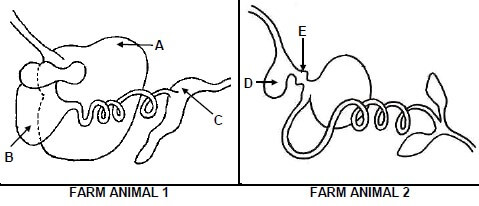
2.1.1 Which farm animal above (FARM ANIMAL 1 or FARM ANIMAL 2) is a non-ruminant? (1)
2.1.2 Give ONE reason for the answer to QUESTION 2.1.1. (1)
2.1.3 Indicate the type of feed which constitutes the greatest percentage of the ration for FARM ANIMAL 1. (1)
2.1.4 Give ONE reason for the answer to QUESTION 2.1.3. (1)
2.1.5 Write down the letter (A–E) of the part that enables FARM ANIMAL 1 to digest the type of feed in QUESTION 2.1.3. (1)
2.1.6 Explain how EACH of D and E in FARM ANIMAL 2 assist in the digestion of grain feed. (2)
2.2 The diagram below is a schematic representation of the energy flow in a farm animal. 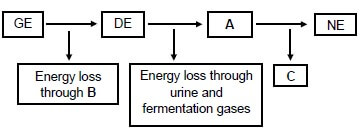
2.2.1 Refer to the schematic representation above and identify A, B and C. (3)
2.2.2 Identify the type of energy that serves as a potential energy value of a feed. (1)
2.2.3 Write down the formula used to work out digestible energy. (1)
2.2.4 Give TWO reasons why net energy is important to livestock. (2)
2.3 The table below shows feeds with different biological values (BV) and energy values.
TYPE OF FEED | BIOLOGICAL VALUE (BV) | ENERGY VALUE (%) |
Maize | 60 | 80 |
Fishmeal | 90 | 30 |
Lucerne | 75 | 45 |
Barley | 50 | 60 |
2.3.1 Identify, with a reason, a feed in the table above that will be suitable for:
- Growing calves (2)
- Cattle fattened for sale (2)
- Non-producing cows (2)
2.3.2 Give a reason for the high biological value of lucerne compared with the biological value of barley. (2)
2.4 Farm animals have certain fodder requirements at various stages of growth and production. The table below represents feed requirements and resources available over a twelve-month period.
ITEM | FIRST 6 MONTHS (RAINY SEASON) | LAST 6 MONTHS (DRY SEASON) | TOTAL |
Need per cow per day | 12 kg | 15 kg | |
Feed requirements in 6 months | 108 000 kg | … | … |
Resources available per month (kg) | 1,5 ton/ha | 0,15 ton/ha | 415 800 kg per year |
Total area for camps (ha) | 42 | 42 | 42 |
Number of animals | 50 | 30 |
2.4.1 Calculate the total feed required by the animals for a year. Show ALL calculations. (3)
2.4.2 Calculate, in kilogram (kg), the amount of available feed in the camps in the dry season. (2)
2.4.3 Refer to the values in QUESTION 2.4.2 and identify the feed flow problem that the farmer will encounter in the dry season. (2)
2.4.4 Give a sustainable action the farmer needs to take to reduce the impact of the problem in QUESTION 2.4.3. (1)
2.5
A balanced ration of maize meal with 14% DP and sunflower oilcake meal with 45% DP was prepared for a dairy herd. The feeds were mixed at a ratio of 12 : 19. The animals' digestible protein requirement is 26%. |
2.5.1 Determine the amount of EACH feed needed to prepare 600 kg of the ration if maize meal is 61,29% and sunflower oilcake meal is 38,71%. (4)
2.5.2 Indicate the feed that will constitute 19 parts. (1)
[35]
QUESTION 3: ANIMAL PRODUCTION, PROTECTION AND CONTROL
Start this question on a NEW page.
3.1 The table below represents information on the floor space required for pigs per live mass.
LIVE MASS (kg) | FLOOR SPACE REQUIRED FOR 10 PIGS (m2) |
20 | 14 |
40 | 22 |
60 | 30 |
80 | 37 |
100 | 42 |
120 | 47 |
140 | 53 |
3.1.1 Draw a bar graph to indicate the live mass of pigs and the floor space they require. (6)
3.1.2 Refer to the table above and indicate the trend in terms of floor space required in relation to the live mass of pigs. (2)
3.2 The photograph below shows an apparatus used to perform certain livestock management practices.
3.2.1 Identify the apparatus above. (1)
3.2.2 Name TWO management practices for this apparatus in sheep. (2)
3.2.3 Give ONE reason why EACH management practice in QUESTION 3.2.2 is important. (2)
The loading and transportation of farm animals may cause enormous stress and physical injuries. Proper facilities should be used when loading animals. A permit must be carried when transporting farm animals. |
3.3.1 Name the facility used to direct farm animals towards the loading ramp. (1)
3.3.2 Give TWO measures to consider when designing the facility in QUESTION 3.3.1. (2)
3.3.3 Identify the relevant document to be carried by the driver when transporting farm animals. (1)
3.3.4 State TWO precautionary measures a farmer has to take to reduce stress when transporting farm animals. (2)
3.4 The picture below represents the life cycle of a type of fly that attacks farm animals, especially wool sheep.
3.5 Identify the control measures a farmer may take to prevent plant poisoning in EACH of the following situations: 3.4.1 Identify the parasite in the life cycle above. (1)
3.4.2 Indicate the most harmful stage in the life cycle of this parasite. (1)
3.4.3 Identify the condition caused by the stage in QUESTION 3.4.2 that occurs in the wounds of wool sheep. (1)
3.4.4 Give the term used for the removal of wool around the tail and rear leg areas. (1)
3.4.5 Name THREE non-chemical management practices used to control infestation by this parasite. (3)
3.5.1 Animals graze after being transported over long distances (1)
3.5.2 Animals feed on hay kept in stables (1)
3.5.3 Overgrazed or overstocked camps (1)
3.6
H1N1 is a respiratory disease of fowls caused by the Type A influenza virus. This disease is very resistant and can remain infectious for many months. Swine fever is also a highly contagious, notifiable viral disease. The organism causing the disease can remain viable for several weeks in unprocessed pig meat. Both diseases are enzootic. |
3.6.1 Name the pathogen responsible for both H1N1 and swine fever. (1)
3.6.2 Identify a common characteristic of H1N1 and swine fever. (1)
3.6.3 Give TWO roles of the state in controlling the spreading of these diseases. (2)
3.6.4 State TWO economic implications of these diseases. (2)
[35]
QUESTION 4: ANIMAL REPRODUCTION
Start this question on a NEW page.
4.1 The graph below shows the volume and concentration of semen in different farm animals. 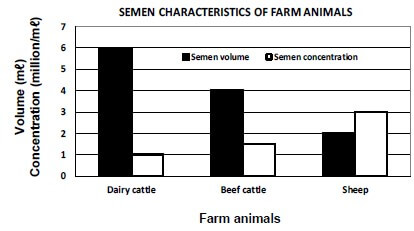
4.1.1 Determine the concentration of semen at a volume of 6 mℓ in dairy cattle. (1)
4.1.2 Refer to the graph and give the correlation between semen volume and semen concentration of dairy cattle and sheep. (4)
4.2 The colour and quality of semen will determine the success of artificially inseminating livestock.
4.2.1 Give a reason why semen could have the following colour:
- Red (1)
- Grey (1)
4.2.2 State TWO ways in which the quality of semen may be negatively affected. (2)
4.3
Breeders are using new methods to increase the number of offspring and to improve the genetics of the progeny. Choosing the appropriate time to calve is also vital.
|
4.3.1 Choose a technique in the scenario above that matches EACH of the procedures that follow:
- The nucleus containing DNA is removed from the egg cell and the egg cell is enucleated. (1)
- A viable embryo is recovered from the donor using a Foley catheter. (1)
- Viable semen is harvested through electro-ejaculation. (1)
- Use somatic cells to produce a genetically identical organism. (1)
4.3.2 State the correct stage of the oestrus cycle to inseminate cows successfully. (1)
4.3.3 Why is the relationship between ovulation and the timing of insemination important? (3)
4.4 DIAGRAMS A and B below illustrate multiple births in farm animals.
4.4.1 Identify the TWO types of twins in DIAGRAMS A and B. (2)
4.4.2 Motivate the answer to QUESTION 4.4.1. (2)
4.4.3 Name the process that takes place in DIAGRAM B to produce this type of twins. (1)
4.4.4 Give ONE reason why the twins in DIAGRAM A will probably NOT be of the same gender. (1)
4.4.5 Name THREE factors that are responsible for the occurrence of multiple births. (3)
4.5 Calves that are incorrectly positioned before and during the time of parturition will cause difficult calving.
4.5.1 Refer to the pictures of foetal positions (A–C) above and identify the parturition stage. (1)
4.5.2 Give the correct scientific name for the calving difficulty that might be caused by foetal positions A, B and C. (1)
4.5.3 Suggest TWO actions that a farmer can take to save both the calf and the cow during calving difficulty. (2)
Milk ejection is initiated by the stimulation of the central nervous system, which is brought about by the milking action of the milker. The udder must be healthy and needs to be observed at all times to ensure optimal milk production. |
4.6.1 Give TWO stimuli initiated by the milker during the milking process. (2)
4.6.2 Name the hormone responsible for milk ejection. (1)
4.6.3 What hormone inhibits milk ejection? (1)
4.6.4 State the bacterial disease that affects the udder. (1)
[35]
TOTAL SECTION B: 105
GRAND TOTAL: 150
